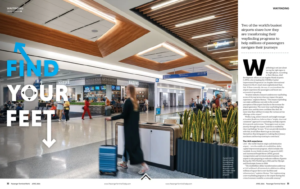Wesley Lang, senior research and insight manager at Heathrow Airport, sat down with Passenger Terminal Today to reveal more about the airport’s wayfinding study, its top insights and its implications for future initiatives and terminal design.
Why was the wayfinding study needed? What were some of the key problems?
During the Covid-19 pandemic, we needed to add a lot of additional signage and information throughout the passenger journey. As passenger volumes began to return, we started to see declines in satisfaction with wayfinding at Heathrow. So, there was a need to assess our wayfinding messaging to ensure passengers received a predictable and reliable journey. The hypothesis of the study was that we would get a read on optimal flow paths and poorly performing strategic signs.
When did the study run and what did it involve?
The project ran from December 2022 to January 2023. It involved intercepting passengers at a number of key journey touchpoints e.g. arrival at the airport, check-in, after security, disembarkation and baggage reclaim. Participants were then asked to continue on their journey from these points and we tracked their eye movements throughout and followed it up with a qualitative depth interview at the end focusing on key challenges they faced along their journey.
How did technology help monitor wayfinding? Did you analyze passenger behaviors?
It was extremely useful to have the view of the passenger via the eye-tracking system and have a real-time view of what they were struggling with on their journeys. One of the problems with working at an airport is that you quickly go into autopilot when you are walking through the airport, making it more difficult for you to understand the challenges from the perspective of someone brand new to navigating through it.
What were some of the key findings from the study?
One of the key findings was that, for the majority of passenger journeys, the wayfinding is generally very good at Heathrow. However, we need to be consistent with our approach across the whole journey, for example, avoiding temporary tactical signage below head height and working on consolidating the volume of signage we have.
What changes have been made to wayfinding at Heathrow because of the study?
We have managed to reverse the wayfinding satisfaction declines we were seeing in 2021 and 2022 by rationalizing the end-to-end wayfinding journey, particularly through decluttering walkways and decision points, reconfiguring the entrance to immigration and revamping onward travel signage.
Have changes been made airport-wide or just within specific terminals/facilities?
The study focused on Terminal 5 and the majority of the changes made were focused on this terminal. However, this work also produced a set of best-practice recommendations that have now been applied to Heathrow’s overall wayfinding guidelines and standards to ensure better consistency across all our terminals. In 2024, we are rolling out similar research across other terminals.
What were some of the key challenges faced when deploying the new wayfinding system, and how were these overcome?
The key challenge is making sure that we are consistent with our wayfinding strategy over time. Inevitably, clutter creeps in as different stakeholder teams operate in the terminal and have specific needs.
How did you work with other stakeholders at the airport to ensure a consistent approach to wayfinding?
We have a wayfinding steering group, which I sit on, that has a monthly catch-up to discuss large wayfinding projects and issues. This group covers a wide range of stakeholders from across the business, like solutions, strategy, engineering, commercial, etc and helps keep everyone focused on what the best approach for delivering for our passengers would be. There is also regular sharing of the original report (especially with new starters). Having a report rich in interesting videos and commentary does help the messaging land.
How successful has the wayfinding project been?
It’s been a very strong insight piece for the business. We have a clear overview of T5 and a best-practice one-pager to share with teams around the business. On top of that, the project has led to further work being commissioned in T2 and T3 this year as each terminal has its own unique challenges that need to be assessed.
What are some common mistakes when it comes to wayfinding at airports?
I think the first mistake is to forget that passengers are very likely tired and overwhelmed when traveling. So, we need to be making everything as simple, clear and consistent as possible. This also ties nicely with teams thinking that more information means a better journey. Simple and clear is always better, so regular declutter walkarounds are key to improving journeys. Adding signs about parking or lounges early on an exit path is not useful when it’s not clear what side they need to exit in the first place.
The last mistake is not having some human touchpoints on the journey. We have a very diverse mix of passengers and some of them prefer face-to-face interaction. ‘Notice and care’ is one of our key principles and when I see my team being proactive and guiding people, it really shows that we are following that principle.
Based on what you have learned during this project, what advice would you give to other airports looking to improve wayfinding?
Conduct regular walk-throughs of key journeys to make sure information creep hasn’t happened; get new starters to do a typical journey and feed this experience back. Tobii’s eye tracking really helped solidify the idea that we need more overhead strategic signage, and it highlighted how important large iconograph is, as a large percentage of our passenger profile are not fluent English speakers.
In your opinion, is physical signage more effective than digital?
I firmly think that if you don’t have a good signage/wayfinding strategy, both will fail to do what you want. It’s then a case of deploying the right solution in the right place. Digital screens allow you to easily change messaging throughout the day so provide more flexibility; the downside is that they currently don’t last as long as physical signage.
What are some of the key trends emerging when it comes to wayfinding?
One top trend is the idea that physical signage will be supplemented with wayfinding on personal digital devices, which customers are used to using in their day-to-day lives through Google/Apple Maps. Another is the creation of personalized wayfinding experiences in passengers’ own languages, which can be delivered through augmented reality (AR). This technology acts as someone’s personal guide through the airport.
How can wayfinding be futureproofed?
I don’t think it can. Passenger behavior and needs change continuously over time. What we need to focus on is a very strong base strategy for wayfinding and then regular assessments of the journeys and passenger behavior.
What are some of the key benefits for airports when it comes to improving wayfinding – other than the obvious ones related to improving flow?
Passengers want to get on their flights on time. To ensure this, they want an easy journey through the airport, which is enabled by clear wayfinding. If we can provide passengers with an easy journey through the airport, it will enable them to go on and enjoy themselves, thus being open to making discretionary purchases and leaving wanting to come back again.
For more top insights into Heathrow’s wayfinding program, read Passenger Terminal World’s exclusive wayfinding feature here.


